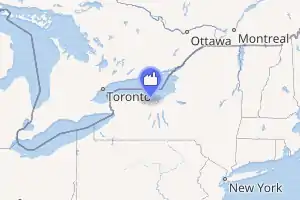R. E. Ginna Nuclear Power Plant
The Robert Emmett Ginna Nuclear Power Plant, commonly known as Ginna (/ɡɪˈneɪ/ ghih-NAY), is a nuclear power plant located on the southern shore of Lake Ontario, in the town of Ontario, Wayne County, New York, approximately 20 miles (32 km) east of Rochester, New York.[2] It is a single unit Westinghouse 2-Loop pressurized water reactor, similar to those at Point Beach, Kewaunee, and Prairie Island. Having gone into commercial operation in 1970, Ginna became the second oldest nuclear power reactor, after nine mile unit 1, still in operation in the United States when the Oyster Creek power plant was permanently shut down on September 17, 2018.[2]
| Ginna nuclear power plant | |
|---|---|
.jpg.webp) Ginna nuclear power plant | |

| |
| Country | United States |
| Location | Ontario, New York |
| Coordinates | 43°16′40″N 77°18′36″W |
| Status | Operational |
| Construction began | April 25, 1966 |
| Commission date | June 1, 1970 |
| Construction cost | $346.15 million (2007 USD)[1] |
| Owner(s) | Exelon |
| Operator(s) | Exelon |
| Nuclear power station | |
| Reactor type | PWR |
| Reactor supplier | Westinghouse |
| Cooling source | Lake Ontario |
| Power generation | |
| Units operational | 1 × 580 MW |
| Nameplate capacity | 580 MW |
| Annual net output | 4930 GW·h |
| External links | |
| Website | Ginna Nuclear Power Plant |
| Commons | Related media on Commons |
History
The plant was named after Robert Emmett Ginna, a former chief executive of Rochester Gas & Electric, who was one of the nation's earliest advocates of using nuclear energy to generate electricity.[3]
Ginna is owned and operated by Exelon after the merger with CENG, who purchased it from Rochester Gas and Electric in 2004.[4][5]
The Ginna plant was the site of a nuclear accident when, on January 25, 1982, a small amount of radioactive steam leaked into the air after a steam-generator tube ruptured.[6][7] The leak which lasted 93 minutes led to the declaration of a site emergency. The rupture was caused by a small pie-pan-shaped object left in the steam generator during an outage. This was not the first time a tube rupture had occurred at an American reactor but following on so closely behind the Three Mile Island accident caused considerable attention to be focused on the incident at the Ginna plant. In total, 485.3 curies of noble gas and 1.15 millicuries of iodine-131 were released to the environment and 1,690 gallons of contaminated water was lost from the reactor.[8]
In 1996 the original Westinghouse supplied steam generators (including the one that was damaged in 1982 and repaired) were replaced by two brand new Babcock & Wilcox steam generators. This project enabled an uprating of Ginna's output several years later and was a major factor in the approval of the plant's operating license extension for 20 years beyond the original license (originally valid until 2009).
Surrounding population
The Nuclear Regulatory Commission defines two emergency planning zones around nuclear power plants: a plume exposure pathway zone with a radius of 10 miles (16 km), concerned primarily with exposure to, and inhalation of, airborne radioactive contamination, and an ingestion pathway zone of about 50 miles (80 km), concerned primarily with ingestion of food and liquid contaminated by radioactivity.[9]
The 2010 U.S. population within 10 miles (16 km) of Ginna was 66,847, an increase of 12.7 percent in a decade, according to an analysis of U.S. Census data for msnbc.com. The 2010 U.S. population within 50 miles (80 km) was 1,269,589, an increase of 2.1 percent since 2000. Cities within 50 miles include Rochester (17 miles to city center). Canadian population is not included in these figures.[10]
Seismic risk
The Nuclear Regulatory Commission's estimate of the risk each year of an earthquake intense enough to cause core damage to the reactor at Ginna was 1 in 76,923, according to an NRC study published in August 2010.[11][12]
See also
References
- "EIA - State Nuclear Profiles". www.eia.gov. Retrieved 3 October 2017.
- "Constellation Energy Ginna Site Description". Constellation Energy. Archived from the original on September 29, 2007. Retrieved July 9, 2007.
- obit. New York Times, May 19, 1996, https://www.nytimes.com/1996/05/19/us/robert-ginna-94-a-champion-of-nuclear-power.html?scp=1&sq=ginna&st=nyt
- "Constellation Energy Press Release, June 10, 2004" Archived October 24, 2007, at the Wayback Machine. www.constellation.com. Retrieved 2007-07-09.
- http://www.exeloncorp.com/Newsroom/pages/pr_20140401_nuclear_Exelon-CENG_Day_1.aspx
- "TRANSMITTAL OF NUREG-0916 RELATIVE TO THE RESTART OF R. E. GINNA NUCLEAR POWER PLANT (Generic Letter No. 82-11)". UNITED STATES NUCLEAR REGULATORY COMMISSION. June 9, 1982. Retrieved 2009-01-09.
- "Nuclear Plant Mishap Is Explained by Utility". The New York Times. March 25, 1982. Retrieved January 9, 2009.
- Schlager. When Technology Fails. ISBN 0-8103-8908-8.
- "Archived copy". Archived from the original on 2006-10-02. Retrieved 2012-02-08.CS1 maint: archived copy as title (link)
- Bill Dedman, Nuclear neighbors: Population rises near US reactors, NBC News, April 14, 2011 http://www.nbcnews.com/id/42555888 Accessed May 1, 2011.
- Bill Dedman, "What are the odds? US nuke plants ranked by quake risk," NBC News, March 17, 2011 http://www.nbcnews.com/id/42103936 Accessed April 19, 2011.
- "Archived copy" (PDF). Archived from the original (PDF) on 2017-05-25. Retrieved 2011-04-19.CS1 maint: archived copy as title (link)
External links
- "New York Nuclear Profile". Energy Information Administration, U.S. Department of Energy (DOE). 2010. Retrieved 2016-11-04.
- R.E.Ginna Homepage